North India -
Tourism Attraction
Taj Mahal, Agra
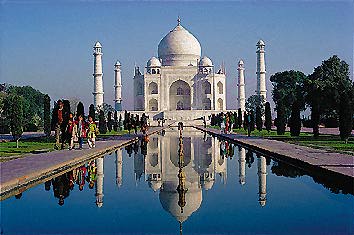
Agra. Where the sun dawns gently over the Taj
Mahal. Where words of undying love need never spoken to be heard. Where white
marble walls, fine filigree trellises and exquisite pietra-dura tell their own
story.
The Taj was built in the memory of the
beautiful queen Mumtaz Mahal who died in child-birth. The bereaved Mughal
emperor, Shah Jahan, had no desire to live except to see a mausoleum built, as
afitting tribute to her extraordinary beauty.
The finest architects were summoned and the
Taj Mahal was crafted as a labor of love over 21 years. Set on the banks of the
River Jamuna, the Taj rises like a lovely lyric in white marble.
Agra is far more than just the Taj. The seat
of the Mughal Empire for years, its forts and mosques reflect Mughal
architecture at its zenith. The Agra Fort with its massive red sandstone walls,
deep moats, heavy draw-bridges and mysterious underground tunnels. Jahangirís
Palace with its symmetrically planned gardens, bubbling fountains, and richly
engraved work on marble is an interesting blend of Hindu and central Asian
architectural styles.
|
|
Delhi
The first reference to the name Delhi seems to have been
made in the 1st century BC when Raja Dhilu built the first city of Delhi near
the site of the future Qutab Minar. Delhi went through many ups and downs and
did not reemerge into prominence until the 12th century A.D., when it was made
the capital of the ruler Prthviraja III. After his defeat later that century,
the city passed into Muslim hands. Qutb-ud-Din Aybak, builder of the famous
tower Qutab Minar (completed in the early 13th century), also chose Delhi as his
capital.
The second city of Delhi was built by Ala-ud-Din Khalji at
Siri, three miles
northeast of the Qutab Minar (near what is today Hauz Khaus and the Asian Games
Village).
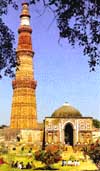
The third city of Delhi was built by Ghiyas-ud-Din Tughluq (1320-25) at
Tughlakabad but had to be abandoned in favor of the old site near Qutab Minar
because of a scarcity of water. The ruins of Tughlakabad are located on the
present-day Delhi-Haryana border towards Faridabad.
His successor, Muhammad ibn Tughluq, extended the city farther northeast and
built new forticications around it. It then became the fourth city of Delhi,
under the name Jahanpanah. The new settlements were located between the old
cities near the Qutab Minar and Siri Fort.
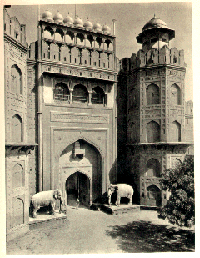
Muhammad ibn Tughluq's successor, Firuz Shah
Tughluq, abandoned this site
altogether and in 1354 moved his capital farther north near the ancient site of
Indraprastha. Thus, the fifth city of Delhi, Firuzabad, was founded on what is
now the Firoz Shah Kotla area. Delhi was invaded and partially destroyed by
Timur at the end of the 14th century, and the last of the sultan kings moved the
capital to Agra.
Babur, the first Mughal ruler, reestablished Delhi as the seat of his empire
in 1526. His son and successor, Humayun, built a new city on the site of the
previously demolished Firuzabad and called in Din Panah. Sher Shah, who
overthrew Humayun in 1540, razed Din Panah and built his capital, the Sher Shahi
(the Old Fort or Purana Qilah), as the sixth city of Delhi.
Delhi once again lost importance when the Mughal emperors Akbar (1556-1605)
and Jahangir (1605-1627) moved their headquarters to Fatehpur Sikri (near Agra)
and Agra, respectively. The city was restored to its glory in 1638 when the son
of Jahangir, Shah Jahan, laid the foundations of the seventh city of Delhi,
Shahjahanabad. What was Shahjahanabad has come to be known as Old Delhi. The
greater part of the city is still confined within the space of Shah Jahan's
walls and several gates built during his rule -- the Kashmiri Gate, the Delhi
Gate, the Turkman Gate, and the Ajmeri Gate -- still stand.
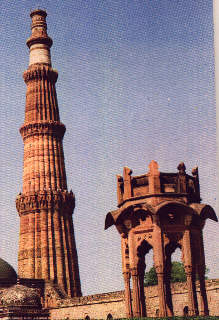
Lal Qila (Red Fort)
The largest of Old Delhi's monuments is Lal
Qila, or Red
Fort (daily dawn-dusk; Rs0.50), whose thick red sandstone walls, bulging with
turrets and bastions, rise above a wide dry moat in the northeast corner of the
original city of Shahjahanabad. The fort covers a semi-octagonal area of almost
2km, its longest walls facing the town in the west and the River Yamuna in the
east. Work was started on the fort - modeled on the royal citadel in Agra - in
1639, and it was completed by 1648. It contains all the expected trappings of
the centre of Moghul government: halls of public and private audience, domed and
arched marble palaces, plush private apartments, a mosque, and elaborately
designed gardens.
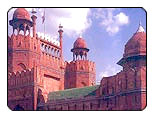
India Gate in Delhi
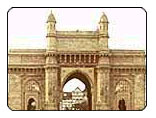 At
the center of New Delhi stands the 42m high India Gate, an "Arc-de-Triomphe"
like Archway in the middle of a crossroad. Almost similar to its French
counterpart war memorial. It commemorates the 70,000 Indian soldiers who lost
their lives fighting for the British Army during the First World War and bears
the names of more than 13,516 British and Indian soldiers killed in the
Northwestern Frontier in the Afghan war of 1919.
At
the center of New Delhi stands the 42m high India Gate, an "Arc-de-Triomphe"
like Archway in the middle of a crossroad. Almost similar to its French
counterpart war memorial. It commemorates the 70,000 Indian soldiers who lost
their lives fighting for the British Army during the First World War and bears
the names of more than 13,516 British and Indian soldiers killed in the
Northwestern Frontier in the Afghan war of 1919.
The foundation stone was laid by His Royal Highness, the Duke of Connaught in
1921 and was designed by Edwin Lutyens. The monument was dedicated to the
nation 10 years later by the then Viceroy, Lord Irwin. Another memorial, Amar
Jawan Jyoti was added much later, after India got its independence. It is in
the form of a flame that burns day and night under the arch to remind the
nation of soldiers who laid down their lives in the Indo-Pakistan War of
December 1971.
The entire arch stands on a low base of red Bharatpur stone and rises in
stages to a huge molding, beneath, which are inscribed Imperial sons. Above on
both sides is inscribed INDIA, flanked by MCM and to the right, XIX. The
shallow domed bowl at the top was intended to be filled with burning oil on
anniversaries but this is rarely done.
Surrounding the imposing structure is a large expanse of lush green lawns,
which is a popular picnic spot. One can see hoards of people moving about the
brightly lit area and on the lawns on summer evenings.
Other places of interest
THE FORT OF AKBAR
Built by Akbar in 1564 and enlarged by the
next three generations, the fort contains the Moti Masjid, Diwan-i- Am,
Diwan-i-Khas, Jehangir Mahal etc. - all of which are the fine examples of the
Mughal architecture.
FATEHPUR SIKRI
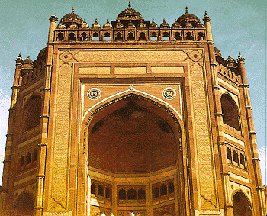
24 miles south west of Agra lies the deserted
sandstone city of Fatehpur Sikri, built by the Mughal Emperor Akbar in 1569 at
the spot where Saint Salim Chisti, who foretold the birth of a son to the
Emperor lived. To commemorate the event, Akbar shifted his Capital there and in
a short span of time a complex of Forts, Palaces and Mosques sprang up. It is
said that Englishmen who came to meet the Emperor at Sikri in 1583 could
scarcely beleive their eyes for the glory and grandeur of the
city.
Because of scarcity of water, Akbar was forced
to abandon the city and Fatehpur Sikri became a ghost town. A number of graceful
buldings adorn the city, the more important of which are :
JAMA MASJID
Built in 1575 and designed to hold 10,000
worshippers, the Mosque excels in symmetry and inlay designs. The Victory Gate,
the Buland Darwaza, with its massive dimensions, dominates the
scene.
Within the courtyard of the Mosque is the
mausoleum of Saint Salim Chisti who had foretold the birth of a son of Emperor
Akbar. Even today thousands of childless women, belonging to all religions, come
to the tomb of this Mohamadan saint, seeking the same blessing that he bestowed
upon the Emperor over 400 hundreds ago.
DIWAN-I-AM
(Hall of public audience)
More than 350 feet long, it consists of an
alcove around a courtyard within which is the Hall of Judgement where Emperor
Akbar sat. Behind the hall is the courtyard where the Emperor played chess using
slave girls as living pieces.
Jammu Kashmir Tourism
Sonmarg
Situated at 9,000
kms. above sea level, Sonmarg is one of the
smallest resorts in Kashmir, lying in the heart of a gorgeous valley carved by
the river Sindh.. Also known as "Golden meadow", this place gets its name 'Son'
meaning golden, from the bloom of yellow crocuses that fill this valley in the
spring. It can be reached by roads, which runs through the picturesque Sind
valley flanked on one side by the densely populated slopes and many varieties of
alpine flowers.
A gushing river is the highlight of this meadow, flowing
down from snowy heights into the dense woodlands of firs and silver birches.
Glaciers pour down from this stream from the Himalayas on to the many camping
sites in Sonmarg. A thick forest cover of sycamore, alpine flowers, silver
birch, fir and pine, Sonamarg offers adventure in the form of treks, sledging,
angling, alpine skiing and white water rafting.
Sonmarg, on the
Srinagar-Leh highway is approximately 110 kms from Srinagar and the road to
Sonmarg passes through the famous Jawahar tunnel. Buses and private taxis can be
hired from Srinagar.
Few world famous landmarks of sonmarg are:
Sam Sand Dunes-
Jaisalmer, Rajasthan.
Welcome to the world of the Thar
Desert, the land of Sam Sand Dunes, of adventure and rugged expeditions! Explore
the undisturbed beauty, the rich culture
and the picturesque sand dunes!
Any trip to Jaisalmer is indeed,
incomplete, without a trip to the most panoramic dunes of Sam where the wind is
unceasingly carving out scenic patterns, on the sand!

The dunes touched by the wind, and
therefore becoming as it were wrinkled, create a mystical picture, a challenge
to every trigger-happy photographer or filmmaker. Nevertheless, you need a
little bit of luck with the clouds, that means no clouds at all. The best point
of time is of course is sunrise or sunset.
Ajanta caves,
Aurangabad
The state of Maharashtra is
blessed with a rich heritage of ancient monuments and exquisite architectural
marvels representing different phases of development in the art and
architectural style. The prime rock-cut architectural examples of the cave
temples that are spread all over the state are the caves of Ajanta and Ellora.
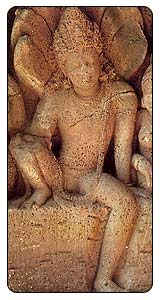
Ajanta caves including the unfinished ones are thirty in number; of which five
- 9, 10, 19, 26 and 29 are 'Chaitya-Grihas' and the rest are 'Sangharamas' or
'Viharas' (monasteries). After centuries of oblivion, these caves of Ajanta
were discovered in AD 1819. They fall into two distinct phases with a break of
nearly four centuries between them. All the caves of the earlier phase date
between 2nd century BC - AD.
Ajanta caves of the second phase were excavated during the supremacy of the
Vakatakas and Guptas. According to inscriptions, Varahadeva, the minister of
the Vakataka king, Harishena (c. 475-500 AD), dedicated Cave 16 to the
Buddhist Sangha while Cave 17 was the gift of the prince, a feudatory. An
inscription records that - Buddha image in Cave 4 was the gift of some
Abhayanandi who hailed from Mathura.
A few paintings, which survive on the walls of Caves 9, and 10 go back to the
2nd century BC-AD. The second group of the Ajanta cave paintings started in
about the 5th century AD and continued for the next two centuries as,
noticeable in later caves. The themes are intensely religious in tone and
centre round Buddha, Bodhisattvas, incidents from the life of Buddha and the 'Jatakas'.
Ajanta cave paintings are executed on a ground of mud-plaster in the tempera
technique.
Ellora
caves, Aurangabad
The magnificent group of rock-cut shrines of
Ellora, representing three different faiths, Buddhist, Brahmanical and Jaina
were excavated during the period from 5th to the 13th century AD. Ellora
Buddhist Caves (1 to 12) were excavated between the 5th and the 7th centuries
AD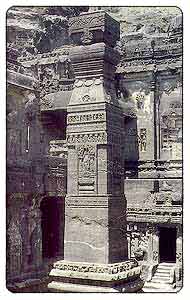 ,
when the Mahayana sects were flourishing in the region. Important in this
group are Caves 5, 10 and 12.
,
when the Mahayana sects were flourishing in the region. Important in this
group are Caves 5, 10 and 12.
Cave 10 is a Chaitya-hall and is popularly known as 'Visvakarma'. It has a
highly ornamental facade provided with a gallery and in the Chaitya-hall is a
beautiful image of Buddha set on a Stupa. Among the Viharas, Cave 5 is the
largest. The most impressive Vihara is the three - storeyed cave called 'Tin -
Tala'. It has a large open-court in front which provides access to the huge
monastery. The uppermost storey contains sculptures of Buddha.
The Brahmanical caves of Ellora numbering 13 to 29 are mostly Saivite.
Kailasha (Cave 16) is a remarkable example of rock-cut temples in India on
account of its striking proportion, elaborate workmanship architectural
content and sculptural ornamentation. The whole temple consists of a shrine
with Linga at the rear of the hall with Dravidian Shikhara, a flat-roofed
Mandapa supported by sixteen pillars, a separate porch for Nandi surrounded by
an open-court entered through a low Gopura. There are two 'Dhvajastambhas', or
pillars with the flagstaff, in the courtyard. The grand sculpture of Ravana
attempting to lift mount Kailasha, the abode of Siva, with his full might is a
landmark in Indian art.
The Jaina Caves (30 to 34) are massive, well-proportioned, decorated and mark
the last phase of the activity at Ellora.
Gateway of India, Mumbai
The Grand and Magnificent Landmark Of
Mumbai
Mumbai's
principal landmark, the Gateway of India is a huge archway on the water's
edge at Apollo Bunder. It is the starting point for most tourists who want
to explore the city. This famous Indian monument was built to commemorate
the visit of the first ever British Monarch, King George V and Queen Mary in
1911.
The Gateway of India was built by the British and designed by the architect
George Wittet. The first stone was laid by the then Governor of Bombay on
March 31st, 1913. The Gate was formally opened in 1924.
It is 26m high structures, complete with four turrets and intricate
latticework carved into the yellow basalt stone. Ironically, when the
British Raj ended in 1947, this colonial symbol also became a sort of
epitaph: the last of the British ships that set sail for England left from
the Gateway.
A Major Sightseeing Hangout - Gateway of India, Mumbai
Behind the arch, there are steps leading down to the water. Here, one can
get onto one of the bobbing little motor launches, for a short cruise
through Mumbai's splendid natural harbour. One can buy tickets for a short
cruise on the motor launches from here.
Near the Gateway of India is Taj Mahal Hotel, one of the most famous and
luxurious hotels in India. Close by are the statues of the Maratha leader
Shivaji astride his horse and of Swami Vivekananda, that add to the charm of
this Indian monument





 At
the center of New Delhi stands the 42m high India Gate, an "Arc-de-Triomphe"
like Archway in the middle of a crossroad. Almost similar to its French
counterpart war memorial. It commemorates the 70,000 Indian soldiers who lost
their lives fighting for the British Army during the First World War and bears
the names of more than 13,516 British and Indian soldiers killed in the
Northwestern Frontier in the Afghan war of 1919.
At
the center of New Delhi stands the 42m high India Gate, an "Arc-de-Triomphe"
like Archway in the middle of a crossroad. Almost similar to its French
counterpart war memorial. It commemorates the 70,000 Indian soldiers who lost
their lives fighting for the British Army during the First World War and bears
the names of more than 13,516 British and Indian soldiers killed in the
Northwestern Frontier in the Afghan war of 1919.


 ,
when the Mahayana sects were flourishing in the region. Important in this
group are Caves 5, 10 and 12.
,
when the Mahayana sects were flourishing in the region. Important in this
group are Caves 5, 10 and 12.